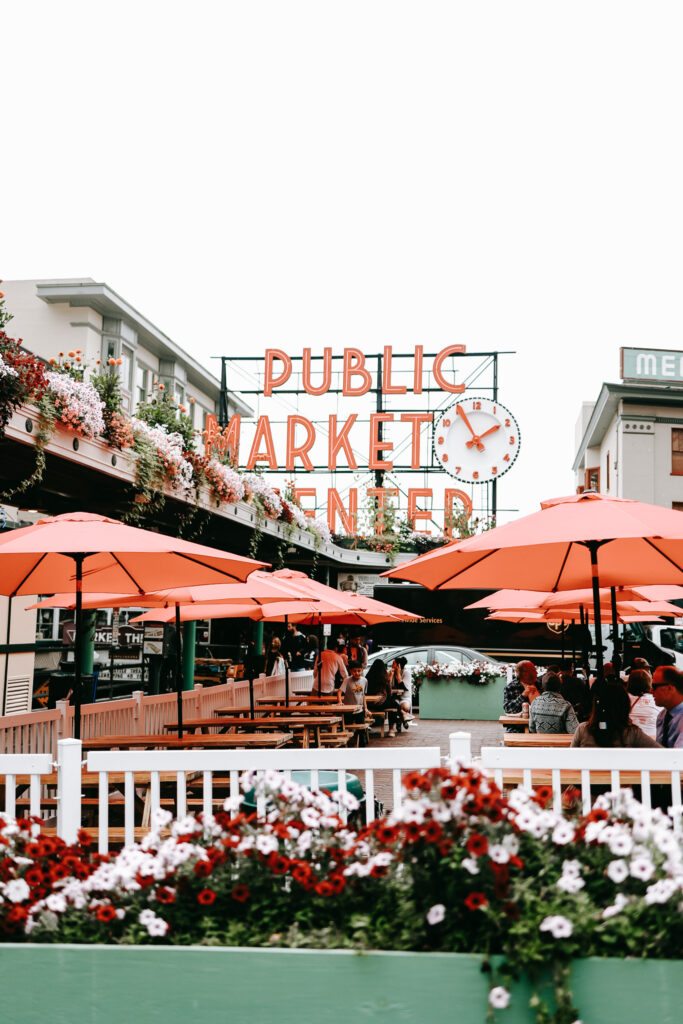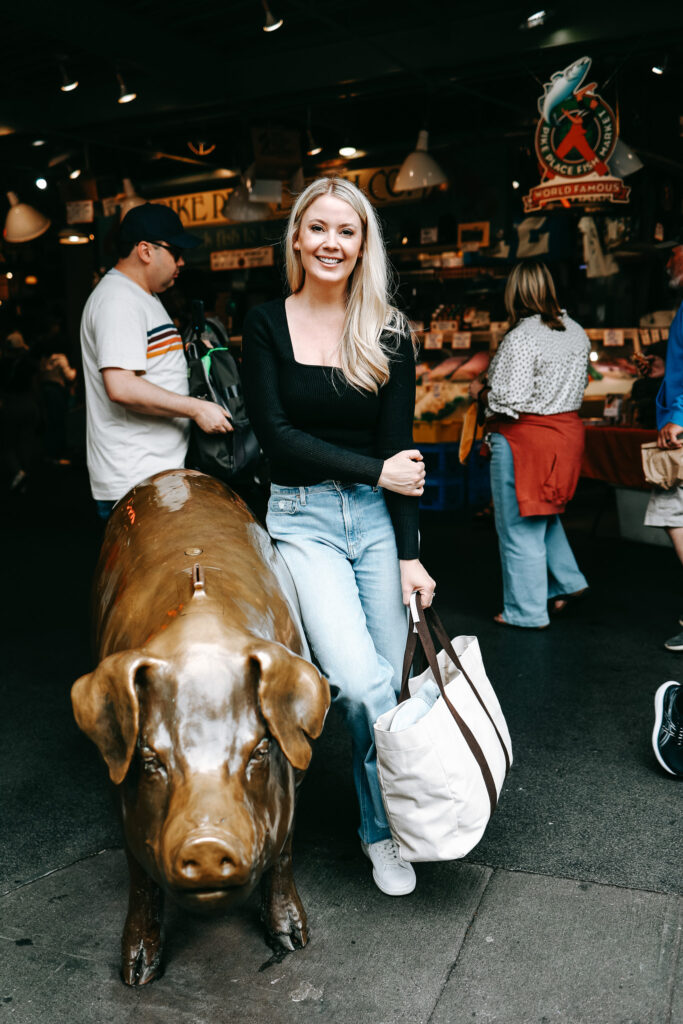From humble beginnings in 1907, Pike Place Market USA was born out of a revolution against high food prices, establishing a direct and fair marketplace for local farmers and Seattle’s consumers.

Pike Place Market holds a storied place in the heart of Seattle, woven deeply into its urban fabric since its inception in 1907.
Nestled in the heart of Seattle with a view overlooking Elliott Bay, Pike Place Market isn’t just a public market—it’s an emblem of community resilience and innovation.
Since its inception in 1907, the Market has stood as a beacon of direct consumer-to-producer commerce, thriving on a foundation built during a period of economic frustration. This article explores the rich history of Pike Place Market, highlighting how it has grown from a simple farmers’ market to a vibrant community hub.
The Birth of Pike Place Market
The story of Pike Place Market begins in the early 20th century amid rising food prices that were affecting both consumers and producers.
The burden of middlemen in the food industry led to inflated prices for buyers and unfairly low profits for sellers. During this period, Thomas P. Revelle, a visionary Seattle City Councilman, proposed the idea of a public market. His concept was to create a space where farmers could sell directly to consumers, cutting out the middlemen and hopefully stabilizing prices.
On August 17, 1907, Pike Place Market USA was established and opened for business, turning a simple street (Pike Place) into a bustling marketplace.
On that first day, eight farmers sold their produce directly from the backs of their wagons to a crowd of over 10,000 people!
The overwhelming success of this first day not only validated Revelle’s vision but also marked the beginning of what would become a historic market.
Who Established Pike Place Market?
The idea for the market originated with Thomas P. Revelle, a Seattle City Councilman, who saw an opportunity to help both farmers and consumers.
Revelle proposed a public marketplace where farmers could sell directly to consumers, eliminating the middlemen and hopefully reducing prices while increasing profits for the farmers themselves. His vision was to create a “farmers’ market” where the exchange between producer and consumer could be more equitable.
The city provided space along Pike Place, a cobblestone street overlooking Elliott Bay. The market opened on August 17, 1907 with eight farmers bringing their wagons loaded with produce. The response was overwhelming, with the farmers’ stocks selling out quickly to a crowd of eager customers. This immediate success solidified the market’s place in the community, and it rapidly grew from there.
The market was not only a practical response to economic pressures but also a social innovation that strengthened the bonds between rural producers and urban consumers. It fostered a community-centric approach to buying and selling that has lasted over a century, turning Pike Place Market into a cherished institution in Seattle.
The market’s early years were characterized by rapid growth and expansion. By the 1920s, it had become a bustling hub of activity, with hundreds of farmers and an increasing number of craftspeople and merchants.
Challenges and Triumphs
As Pike Place Market grew, it faced numerous challenges, including proposed demolition plans in the 1960s to make way for urban redevelopment. This sparked a major “Save the Market” campaign, driven by passionate locals who recognized the Market’s value beyond commerce.
In 1971, this culminated in a city-wide referendum where voters overwhelmingly chose to preserve and renovate the historic site. This victory was pivotal, ensuring that the Market would continue to serve as a community and cultural center.
Pike Place Market Pigs
If you’ve strolled through Seattle’s Pike Place Market, you’ve likely encountered one of its most photographed residents, Rachel, a life-sized bronze piggy bank that has become a symbol of the market’s vibrant community spirit. But did you know that Rachel has a friend? There is a second bronze piggy bank named Billie, too.

Rachel The Pig: The Original Pike Place Market Mascot
In 1986, Pike Place Market introduced a unique fixture that would soon become a beloved icon. Rachel, a bronze sculpture created by Washington artist Georgia Gerber, was modeled after a real pig named Rachel who won a prize at the 1985 Island County Fair. Weighing in at 550 pounds, this piggy bank was not just a piece of art but a functional donation box.
Positioned under the iconic “Public Market Center” sign and clock, Rachel quickly became more than a novelty; she turned into a central hub for contributions to The Pike Place Market Foundation. This organization plays a critical role in supporting the market community, funding a variety of social services including healthcare, housing, and a food bank. Visitors and locals alike often drop coins and bills into Rachel, assisting in these community efforts, while also indulging in a bit of superstition by rubbing her nose for good luck.
Billie Joins the Family
Recognizing Rachel’s popularity and the need to manage the crowd around her, Pike Place Market in 2011 decided to bring another piggy bank to the scene.
Billie, stationed at the market’s main entrance at Pike Street and Pike Place, serves as an additional fundraising beacon. Named Billie to complement Rachel, this piggy bank helps to disperse the crowd flow and encourages more donations, supporting the Market’s philanthropic missions just as effectively.
Over the years, Rachel and Billie have become much more than just sculptures; they are integral to the identity of Pike Place Market. They symbolize the generosity and community focus of the Market, embodying its spirit and its commitment to supporting the less fortunate. The tradition of decorating these pigs according to season or for special events adds a playful element that keeps their appeal fresh and engaging.
These piggy banks have collected hundreds of thousands of dollars over the years, directly contributing to the welfare of the market’s diverse community.
The next time you visit Pike Place Market, don’t forget to say hello to Rachel and Billie, drop a coin for a good cause, and maybe rub a snout for a bit of luck in your adventures through Seattle.
To navigate from Rachel the Pig to Billie the Pig at Pike Place Market, visitors can enjoy a straightforward and scenic walk. Here’s a simple guide to help visitors make their way between these two beloved sculptures:
- Start at Rachel the Pig: Rachel is located under the iconic “Public Market Center” sign and clock, near the corner of Pike Place and Pike Street.
- Head North on Pike Place: Begin your walk by moving north along Pike Place. This is the main thoroughfare of the market, and you’ll be walking against the usual flow of traffic on this cobblestone street.
- Enjoy the Sights: As you walk, take in the vibrant atmosphere of the market. You’ll pass by various vendors selling fresh flowers, handmade crafts, and local produce. The hustle and bustle of market activity will surround you, providing a truly immersive Seattle experience.
- Reach the Main Entrance: Continue walking until you reach the main entrance of the market at the intersection of Pike Street and Pike Place. You will find Billie the Pig located here, greeting visitors entering from this busy corner.
The walk between Rachel and Billie is short, typically taking just a couple of minutes, depending on the crowd. It’s not just a transfer from one spot to another; it’s an opportunity to experience the heart of Pike Place Market. So, take your time, enjoy the sights and sounds, and maybe stop to try some local specialties along the way!
Market Evolution and Community Impact
Throughout its history, Pike Place Market has continually evolved. It has expanded to include a diverse array of more than 500 shops, restaurants, and vendor stalls. The Market now offers everything from fresh seafood and produce to handmade crafts and antiques, all while maintaining its historical architecture and charm.
Beyond commerce, Pike Place Market has a profound social impact. It houses services such as low-income housing, a food bank, and medical clinics, embodying a model of community support. This aspect of the Market highlights its role not just as a marketplace, but as a community stronghold supporting various social needs.
The Legacy Continues
Today, Pike Place Market remains a beloved landmark in Seattle, attracting both locals and tourists alike. Its legacy is not just in the products sold or the transactions made but in the community it builds and the local economy it supports.
The Market is more than a place to shop; it’s a vibrant community of artisans, farmers, and small business owners, each with their own stories, contributing to the rich tapestry of Pike Place Market.
From its revolutionary beginnings to its status today as a historic and cultural icon, Pike Place Market continues to embody the spirit of direct market commerce and community resilience.
As we look forward to its future, the Market remains a testament to the strength and enduring spirit of the Seattle community, promising to be a cherished gathering place for generations to come.
Comments +